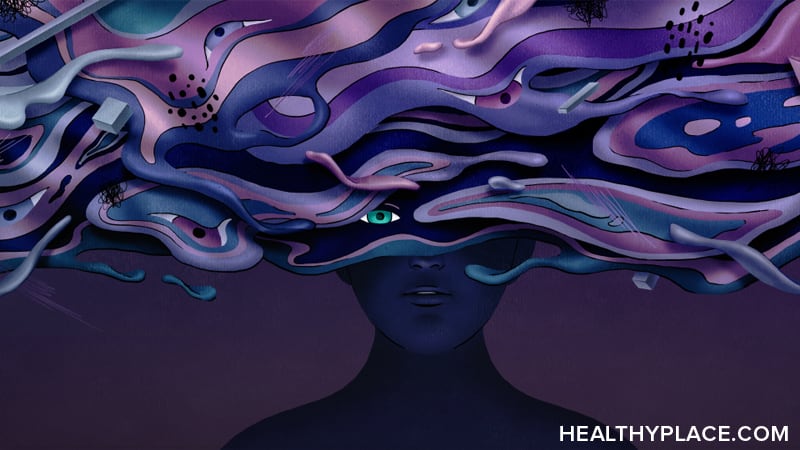Depression with Psychosis: What Should You Look For?

Depression with psychosis is a very real experience. Of people with major depressive disorder, psychosis affects anywhere from 14 to almost 50 percent (Black, 2019). Psychosis is included in the American Psychiatric Association’s Diagnostic and Statistical Manual of Mental Disorders, Fifth Edition (DSM-5) as a specifier, or feature, of major depression and is officially known as major depressive disorder with psychotic features. It’s important to know if someone has depression with psychosis because this illness carries dangerous risks. Here, you can learn more about the illness, including what you should look for.
What is Psychosis?
Psychosis refers to difficulty distinguishing what is real, factual, and tangible from what is not. It involves hallucinations, delusions, or both. Hallucinations are sensory, and people perceive things with their sight, hearing, smell, touch, or taste that aren’t there. Delusions are faulty beliefs.
Psychosis is caused by impairment in a specific part of the brain that is involved in distinguishing between external and internal happenings (what’s actually occurring versus our thoughts about ourselves and the world). Psychosis is a symptom or feature of specific mental illnesses like schizophrenia, bipolar disorder, or depression. Let’s look at psychosis as it occurs in depression.
The Nature of Depression with Psychosis
People can experience two different types of psychotic features with their depression: mood-congruent and mood-incongruent. Their hallucinations or delusions (delusions are far more common in psychotic depression) might match the experience of depression, or they might be completely unrelated to the other symptoms of depression. Sometimes, people experience a mix of the two; however, this isn’t an official specifier in the DSM-5.
Mood-incongruent psychoses aren’t as common as those that fit depression. They don’t follow typical depression themes like guilt or hopelessness. Instead, someone who has mood-incongruent symptoms might excessively fear losing their home to fire because they believe their house doesn’t meet the fire code or that firefighters wouldn’t want to come to their house to help if there was a fire. While such delusions are unrelated to depression symptoms, they can deepen depression.
Usually, someone’s delusions match the thought and emotional patterns of depression. Symptoms typically follow one or more of these themes:
- personal inadequacy, guilt, and deserved punishment
- health and disease
- death
- poverty
- nihilism (the sense that once-held morals, convictions, or ideals no longer have value and life is hopeless, worthless)
In depression, someone turns these beliefs, deeply held and unrealistic (or out of proportion with reality), against themselves. They fuel the self-loathing that is already a part of depression and can further zap energy and motivation, interfere in sleep that’s already a problem, and more.
Depression with psychosis can be devastating. The suicide rate is five times higher than in depression without psychotic features (Brain & Behavior Research Foundation, 2011). It’s important to know what to look for in yourself or a loved one so you can get help.
What to Look for in Depression with Psychosis: A Checklist
To get the proper treatment, it’s necessary to look for symptoms of depression and symptoms of psychosis. The symptoms are intertwined, so also look for how they impact each other and your life.
Use this list as a checklist to help determine whether you are experiencing depression with psychotic features and how severely it’s affecting you. Are you or a loved one experiencing:
- Low mood and prolonged sadness
- Difficulty concentrating
- Fatigue and general lack of energy
- Irritability
- Changes in appetite, weight
- Changes in sleep (significantly more or less than what’s usual for you)
- Lack of motivation, apathy
- Psychomotor agitation (feeling keyed up, restless) or slowing down
- A sense of guilt for what you think you’ve done, not done, or who you perceive you are
- Repetitive thoughts and fears about your health, such as a strong belief you have cancer, despite doctors and medical tests proving otherwise
- A strong belief that you deserve to be punished or that your depression or other conditions happened to punish you
- Seeing or hearing things that aren’t there
The Brain & Behavior Research Foundation (2011) reports that certain depression symptoms, if severe enough, can point to depression with psychosis:
- more pronounced or extreme psychomotor agitation or slowing down than what is often seen in depression
- more severe cognitive impairment (difficulties with thinking, processing, memory, etc.)
- co-occurring anxiety disorders
- co-occurring sleep disorders
Depression with psychotic features has risk factors. If these apply to you, you may want to watch closely for the other symptoms listed above:
- Childhood trauma (For example, did you lose a parent? Experience abuse? A disaster?)
- Age (Older age, above 60, is a risk factor for psychotic depression)
Knowing what to look for to spot depression with psychosis can be lifesaving. Treatment is available, and with proper depression treatment, the prognosis is excellent (2019). You can recover from this illness and live a quality life.
APA Reference
Peterson, T.
(2021, December 30). Depression with Psychosis: What Should You Look For?, HealthyPlace. Retrieved
on 2025, November 27 from https://www.healthyplace.com/depression/symptoms/depression-with-psychosis-what-should-you-look-for



